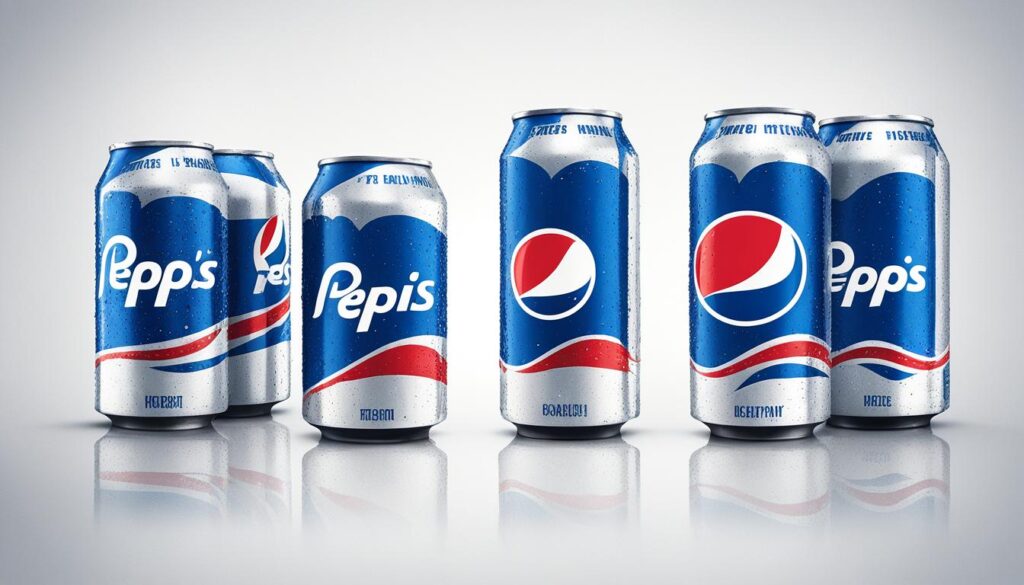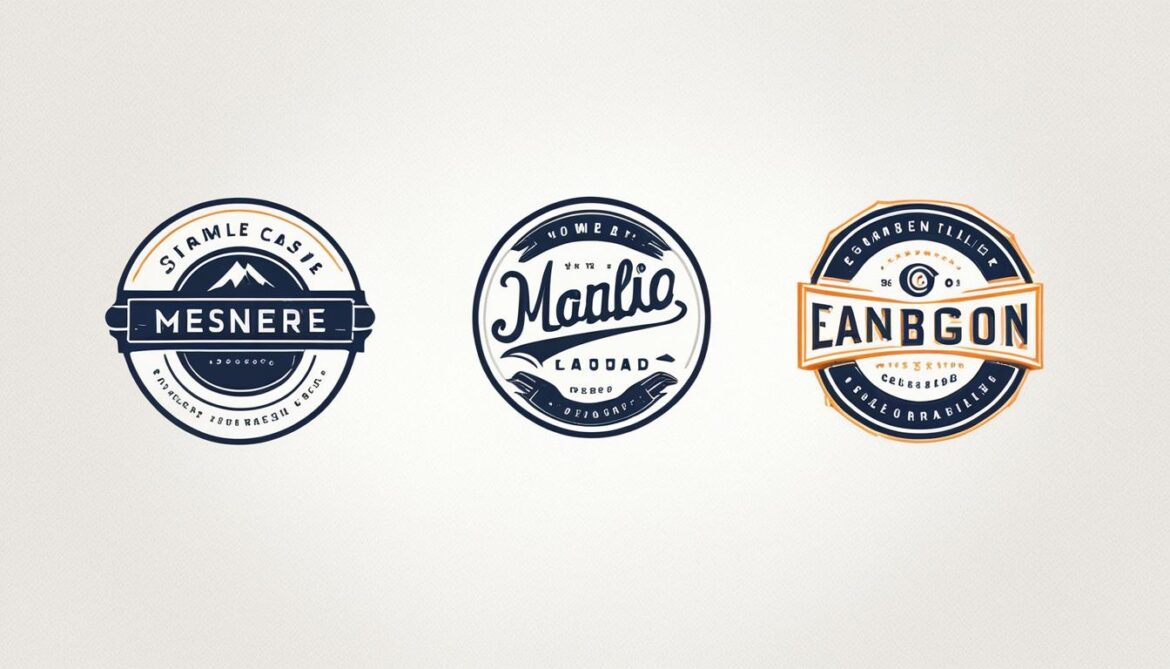A bad logo design can have a significant negative impact on a brand. When companies spend millions of dollars designing their corporate logos, it is for a good reason. The public and shareholders can react harshly to a bad logo design, as seen when the clothing retailer, Gap, attempted to refresh its logo in 2010.
Research conducted by an international team of researchers suggests that people make complex assessments of a company or product based on the shape of the logo. Circular shapes are associated with softness and evoke perceptions of a caring and warm company, while angular shapes activate associations with hardness and durability. Logo design can also influence perceptions of product comfortableness and customer service quality.
Key Takeaways:
- Bad logo designs can harm a brand’s reputation.
- Logo shape can influence consumer perceptions.
- Circular shapes convey softness, while angular shapes evoke hardness.
- Logo design affects perceptions of product comfortableness and customer service quality.
- Investing in a well-designed logo is crucial for brand success.
The Importance of a Simple and Memorable Logo
When it comes to logo design, simplicity is key. Memorable logos are often characterized by their clean and straightforward designs that effectively communicate a brand’s identity. A simple logo design instantly captures the essence of a brand without unnecessary complexity, making it easier for customers to remember and recognize.
A good logo should be visually appealing and leave a lasting impression on the audience. By embracing simplicity, a logo becomes more versatile, allowing it to be used across various applications and platforms without losing its impact. Whether it’s on a website, a product, or a promotional material, a simple logo design maintains its integrity and remains recognizable in different contexts.
In contrast, complicated logo designs can be overwhelming and fail to convey a brand’s message effectively. Ineffective typography, poor color choices, and a lack of relevance to the brand’s identity are common pitfalls in logo design that can hinder memorability and dilute the brand’s message.
The Power of Simplicity in Logo Design
Simple logo designs have proven to be powerful tools in establishing brand recognition and recall. Let’s take a look at some iconic logos that exemplify simplicity:
| Brand | Logo |
|---|---|
| Nike | |
| Apple | |
| Mcdonald’s |
These brands have created iconic logos that are instantly recognizable and memorable. The simplicity of their designs allows them to capture the essence of the brand without overwhelming the viewer with unnecessary details. These logos have become synonymous with their respective brands and have stood the test of time.
When designing a logo, it’s crucial to prioritize simplicity while staying true to the brand’s values and identity. A simple and memorable logo has the power to leave a lasting impression, build brand recognition, and ultimately contribute to the success of a business.
Common Logo Design Mistakes to Avoid
Effective logo design plays a crucial role in shaping a brand’s reputation and identity. However, there are several common logo design mistakes that can have a negative impact on a brand’s image. By avoiding these pitfalls, brands can ensure their logos effectively convey their message and resonate with their target audience.
Inappropriate Logo Imagery
Using inappropriate imagery in a logo can be detrimental to a brand’s reputation. It’s important to choose imagery that aligns with the brand’s values and target audience. For example, a children’s toy company wouldn’t want to use dark and ominous imagery in their logo. Instead, they should opt for playful and colorful imagery that reflects their brand identity.
Complex Logo Designs
Complex logo designs can be overwhelming and difficult to understand. A cluttered logo can confuse customers and dilute the brand’s message. It’s essential to keep the design simple and avoid incorporating too many elements. By simplifying the design, the logo becomes more memorable and visually appealing.
Ineffective Typography
Typography plays a crucial role in logo design. Using unreadable fonts or inappropriate typography can make a logo look unprofessional and difficult to comprehend. It’s important to choose fonts that are legible and align with the brand’s identity and message. The right typography can enhance the overall design and create a cohesive visual appeal.
Lack of Relevance in Logo Design
A logo should reflect the essence of a brand and visually communicate its values. Lacking relevance in logo design can lead to confusion and disconnect with the target audience. It’s crucial to understand the brand’s identity and ensure that the logo aligns with its core values and resonates with the intended audience.
Lack of Versatility in Logo Design
A versatile logo design is essential to maintain its impact across different platforms and applications. Failing to consider the logo’s versatility can result in a loss of impact when the logo is scaled down or placed on different backgrounds. It’s important to create a logo that maintains its visual integrity and conveys the brand’s message effectively, regardless of its size or placement.
By avoiding these common logo design mistakes, brands can create visually appealing and impactful logos that effectively represent their brand identity, resonate with their target audience, and contribute to their overall success.
Case Study: The Impact of Logo Redesigns
Logo redesigns have the power to make or break a brand. When a company decides to refresh its logo, it is crucial to consider the potential consequences and ensure that the new design resonates with consumers. This section examines three notable logo redesigns that sparked controversy and raised questions about the effectiveness of rebranding.
Tropicana Logo Redesign
In 2009, Tropicana, the renowned orange juice brand, underwent a logo redesign that resulted in a significant backlash. The new design removed the iconic image of an orange with a straw, which had become synonymous with the brand. Consumers felt a deep emotional connection to the original logo and found the redesign to be uninspiring and generic. Tropicana learned firsthand that altering a logo without considering the emotional attachment consumers have can have detrimental effects on brand perception and loyalty.
London 2012 Olympics Logo
The London 2012 Olympics logo redesign faced widespread criticism for its abstract and seemingly disjointed design. The logo, composed of jagged shapes forming the numbers “2012,” deviated from the traditional symbolism associated with Olympic logos, failing to convey the grandeur and tradition of the event. Critics argued that the redesign compromised the Olympic spirit and created confusion among the public. This case study highlights the importance of ensuring that a logo redesign captures the essence of the brand and aligns with audience expectations and perception.
Gap Logo Redesign
The logo redesign of Gap, the clothing retailer, in 2010 sparked immediate backlash from customers. The brand’s original logo, a blue box with bold white lettering, had become a recognizable symbol of the company’s heritage. However, the new logo, featuring a smaller blue box with lowercase white lettering, failed to resonate with consumers. The redesign severed the emotional connection customers had with the brand, leading to widespread disappointment and criticism. This case study emphasizes the importance of maintaining a sense of evolution while honoring a brand’s heritage during logo redesigns.
Successful Logo Redesign Examples
While logo redesigns can be challenging, there are successful examples that demonstrate the power of effective rebranding. Let’s take a look at some notable logo redesigns that have achieved remarkable results:
Meta Rebrand
The Meta rebrand, formerly known as Facebook, has successfully incorporated the concept of the metaverse into its new logo design. The logo features a crisp, minimalist design with an infinity symbol, representing the infinite possibilities of the metaverse. This redesign allowed Meta to showcase its evolution as a company and highlight its focus on building a future where people can connect in virtual spaces.
Renault Logo Redesign
Renault, the renowned automotive manufacturer, underwent a logo redesign that embraced simplicity and modernity. The new logo features geometric shapes, a bold typeface, and an emphasized “R” symbol. This redesign effectively conveys a sense of movement, energy, and direction, reflecting Renault’s commitment to innovative mobility solutions.
Udemy Logo Redesign
Udemy, the popular online learning platform, redesigned its logo with the goal of symbolizing growth and knowledge. The new logo features an upward arrow formed within the letter “U,” representing the upward trajectory of personal and professional development. This redesign aligns perfectly with Udemy’s mission of providing accessible and transformative education to learners worldwide.
Upwork Logo Redesign
Upwork, a leading freelance marketplace, underwent a successful logo redesign focusing on minimalistic design principles. The new logo maintains the recognizable “U” shape while incorporating a fresh and contemporary look. This redesign helped Upwork reinforce its position as a forward-thinking platform that connects businesses with top freelancers.
Volvo Logo Redesign
Volvo, the iconic Swedish automobile manufacturer, introduced a modern and streamlined logo design. The refreshed logo retains the classic Volvo symbol but simplifies the overall design, giving it a cleaner and more contemporary appearance. This redesign exemplifies Volvo’s commitment to innovation, sustainability, and capturing the essence of Scandinavian design.
| Logo Redesign | Brand |
|---|---|
| Meta rebrand | Formerly known as Facebook. Incorporated the concept of the metaverse. |
| Renault logo redesign | Simplified the logo using geometric shapes, creating a sense of movement and direction. |
| Udemy logo redesign | Introduced an upward arrow symbolizing growth and knowledge. |
| Upwork logo redesign | Focused on minimalistic design, maintaining familiarity while improving visual appeal. |
| Volvo logo redesign | Retained the classic Volvo symbol with a cleaner and more contemporary look. |
Logo Redesign Failures
Logo redesigns can sometimes have detrimental effects on a brand’s image and reputation. Several notable examples demonstrate the pitfalls that can occur when redesigning a logo. Let’s explore some logo redesign failures, including the Gap logo redesign, Yahoo logo redesign, and Pepsi logo redesign.
Gap Logo Redesign
The Gap logo redesign in 2010 serves as a cautionary tale for brands attempting to update their visual identity. The new design, featuring a plain Helvetica font and a small blue square, lacked appeal and failed to resonate with customers. Gap’s loyal fan base swiftly expressed their dissatisfaction, leading to a quick reversal of the redesign decision. The failed logo redesign resulted in a loss of brand affinity and a missed opportunity to strengthen the emotional connection with customers.
Yahoo Logo Redesign
Yahoo’s logo redesign also faced significant backlash from both the design community and the general audience. The new logo, introduced in 2013, failed to capture the essence of the brand and appeared unbalanced and lackluster. The overly simplistic design and uninspiring color palette did not resonate with Yahoo’s users, resulting in a missed opportunity to rejuvenate the brand’s image. The unsuccessful logo redesign highlighted the importance of understanding a brand’s unique identity and considering the preferences of its target audience.

Pepsi Logo Redesign
In 2008, Pepsi underwent a logo redesign with the aim of modernizing its visual identity. However, the new logo design received mixed reactions from the public. The inclusion of a circular emblem resembling a smile divided opinions and confused viewers, as it did not effectively convey the desired message. While the logo redesign aimed to communicate a youthful and vibrant image, the abstract symbol failed to resonate with consumers and lacked the impact of its iconic predecessors. Pepsi’s logo redesign serves as a reminder that logo changes should be carefully planned and executed to maintain brand recognition and customer loyalty.
| Logo Redesign Failures | Year |
|---|---|
| Gap | 2010 |
| Yahoo | 2013 |
| Pepsi | 2008 |
When to Consider Logo Redesign
In the ever-evolving world of branding and design, knowing when to redesign a logo is crucial for maintaining a strong visual identity. A logo redesign can breathe new life into a brand, align it with its evolving philosophy, and ensure relevance in a rapidly changing market. Here are some key considerations for when to embark on a logo redesign:
1. Changes in Philosophy
A logo redesign may be warranted when a company undergoes significant shifts in its philosophy or values. For example, if a brand repositions itself to target a different audience or expands its product offerings, a fresh logo can reflect these transformations and effectively communicate the brand’s new direction.
2. Repositioning the Business
When a brand decides to reposition itself in the market, a logo redesign can play a crucial role in signaling this change to its audience. Repositioning may involve entering new markets, targeting a different demographic, or adopting a new brand personality. By updating the logo to reflect these shifts, the brand can capture attention and create a strong visual representation of its new identity.
3. Outdated Design
Over time, logo designs can become outdated, especially when compared to current design trends. If a company’s logo looks stale or out of touch, a redesign can help modernize its visual identity. A fresh and contemporary logo design can make the brand more appealing to the target audience and enhance its overall perception.
4. Relevance to Target Audience and Values
A logo redesign should always consider the brand’s target audience and values. If the current logo fails to resonate with the intended audience or no longer aligns with the brand’s core values, a redesign becomes necessary. The new design should evoke the desired emotional response and convey the brand’s identity effectively.
Before embarking on a logo redesign, it is essential to conduct thorough research, gather valuable feedback, and work with experienced design professionals. By carefully evaluating the need for a redesign and ensuring alignment with the brand’s purpose, target audience, and values, companies can create logos that make a lasting impact and build strong brand recognition.
How to Create a Successful Logo Design
Creating a successful logo design is a crucial step in establishing a strong brand identity. It requires a deep understanding of your target audience and the company’s purpose, mission, vision, and values. By following a few essential tips and involving professional logo design experts, you can create a logo that effectively communicates your brand’s identity and resonates with your audience.
First and foremost, keep your logo design simple yet unique. A clean and minimalistic design allows for easy recognition and makes a lasting impression. Reflect your brand’s ideas and values through the choice of typography and colors, ensuring they align with your overall brand identity.
Start the design process by sketching out basic concepts. This initial step helps you visualize your ideas and experiment with different fonts, abstract shapes, and elements. By focusing on the core essence of your brand, you can create a logo design that embodies its uniqueness and appeals to your target audience.
Consider the versatility of your logo design. It should work well across various applications and maintain its visual integrity when scaled down or placed on different backgrounds. A flexible and adaptable logo design ensures consistent brand recognition and enhances brand credibility.
For the best results, involve professional logo design professionals. They have the expertise and knowledge to create impactful logo designs that capture the essence of your brand. Their experienced insights and creative approach can help you craft a successful logo that effectively represents your brand identity and sets you apart from the competition.
FAQ
What impact can a bad logo have on a brand?
A bad logo design can have a significant negative impact on a brand, leading to negative public and shareholder reactions and potentially harming the brand’s reputation.
What should a good logo design focus on?
A good logo design should focus on simplicity and memorability, effectively communicating the brand’s identity without unnecessary complexity.
What are some common logo design mistakes to avoid?
Common logo design mistakes include incorporating too many elements, using jarring or inappropriate color combinations, using unreadable fonts, and lacking relevance to the brand’s identity.
Can logo redesigns have a profound impact on a brand?
Yes, logo redesigns can have profound consequences for a brand, both positive and negative. They can either successfully convey a brand’s evolution or sever customers’ emotional connections with the brand.
Are there examples of successful logo redesigns?
Yes, examples of successful logo redesigns include Meta’s rebrand, Renault’s simplified logo, Udemy’s upward arrow symbol, Upwork’s minimalistic design, and Volvo’s logo redesign.
Can logo redesigns sometimes result in negative outcomes?
Yes, logo redesigns can sometimes lead to negative outcomes for a brand, such as failing to maintain an emotional connection, creating an imbalance in perception, or confusing viewers.
When should a logo redesign be considered?
Logo redesigns should be considered when a company changes its philosophy, repositions its business, or when the logo looks outdated in comparison to current design trends.
How can a successful logo design be created?
Creating a successful logo design involves understanding the target audience, the company’s purpose, mission, vision, and values, experimenting with fonts and shapes, and ensuring the design effectively communicates the brand’s identity.







